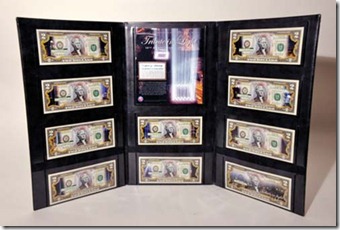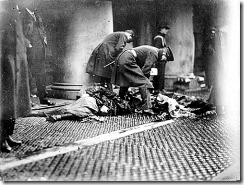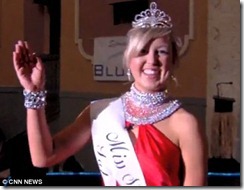It’s hard to believe that we’re fast approaching the tenth anniversary of the September 11th attacks. And it’s hard to believe that we won’t soon be overwhelmed with cheesy commemorative gear to remember the event by. (As if any American much over the age of 15 needs commemorative gear in order to do so.)
I’ve seen the signs already.
Like the first robin harbingering spring, I’ve been seeing ads for 9/11 commemorative $2 bill from the New England Mint.
I always hesitate to dump on any New England company. As long as they’re not doing anything illegal and/or immoral, as long as they’re creating employment, as long as they’re home town honeys, I want to give them a pass.
But the New England Mint?
Oooo, baby. I’m afraid I must make an exception here. It’s way, way, way too difficult to resist poking a bit of fun at this one.
Now, I can understand why someone might want to buy a replica of the 1933 Pontiac hood ornament. Or a bank shaped like a fireman’s boot, which, if nothing else, is useful for collecting for Jerry’s Kids. Or even Dodge City Marshall’s badge, for when you’re in “I carry a badge” mode (as opposed to your normal “We don’t need no stinkin’ badges” frame of mind).
But paying $14.95 (plus, no doubt S&L) for a couple of colorized $2 bills, gussied up to look, well, as phony as a $3 bill….
Who buys this stuff?
Commemorating the 10th Anniversary of the historic events of September 11th, 2001, we are offering the very first Special Edition $2 bills for your collection.
As part of this special collector's edition, you will have the opportunity to commemorate history with a $2 bill signifying a day that will be remembered forever throughout our nation's history. This is a rare opportunity to collect a rare piece of currency that can be passed through generations to retain the motto "Never Forget". Order your 9-11 10th Anniversary $2 Bill today while supplies last.
Well, never forget that you do get those 2 FREE 4” x 7” 4-Panel Archival Folios, plus Certificates of Authenticity. (“We certify that this is a genuine colorized $2 bill.”) Certainly all that’s worth something.
So maybe the supplies won’t last…
If you’re feeling a bit more flush, or a bit more in commemoration mood, there’s the “Tribute in Light” Collection.
This beauty contains all ten of the anniversary bills, which means that the New England Mint has been offering these since 2002. (Way to go with coming up with an annuity stream there!) Yours now, for the low-low price of $199.95 (plus S&L), marked down – lucky you! – from $299.95.
What a piece of work is man who would a) come up with this; b) fall for it.
Yet I’m sure that there are folks who are sincerely patriotic and/or who believe that anything that’s called a “collectible” will increase in value and/or think that that this bit of nonsense has anything to do with the U.S. Mint (which it doesn’t, other than their providing the raw materials, i.e., the oh-so-rare $2 bill that’s used here).
The New England Mint is located in Connecticut. I haven’t looked at the map, but I do believe Norwalk is located in the part of Connecticut that’s Yankees territory, rather than part of the sovereign Red Sox Nation. Which would be ‘nuf said, if not for the fact that Connecticut is both the birth and the death place of Phineas T. Barnum. And that authentic, certified bit of information is brought to you absolutely, bona fide, pinky-swear-on-the-tiny- graves-of –Tom-and-Lavinia-Thumb FREE.
If you’re not feeling 9/11 patriotic, you can get $2 bill sets for the National Parks, Babe Ruth, John Wayne, Dale Earnhardt Jr., Muhammad Ali, and Marilyn Monroe.
A little something for everybody.
Well, not quite everybody.
If they were after everybody’s money, we’d be seeing Arthur Miller $2 bills, not just Marilyn Monroe’s.
Maybe this all makes sense?
After all, in the bleak days following the attacks, didn’t the president urge us all to go out and shop?
Perhaps this was what he had in mind.
Meanwhile, caveat emptor: it doesn’t take a whole lot of googling to find a bushel basket full of complaints about the New England Mint – most around credit card overcharges, shipments of unordered merch, etc.
Then there’s a wonderful deconstruction of the New England Mint’s TV ad (this was for the rendition which “honored” our National Parks) done by Michael Ott over on Suite 101.
Among other goodies, the bills aren’t colorized:
The New England Mint adheres a vinyl overlay to a genuine U.S. two-dollar bill. It is legal tender. The vinyl overlay can be easily removed.
That’s because adding a vinyl overlay doesn’t count towards defacing U.S. currency.
As Michael continues,
In other words — if a child were to refer to himself as a mint, wipe his bottom with a two-dollar bill, he could hawk it as a genuine U.S. two-dollar bill honoring toilet paper….
He also notes that, rather than being rare:
As of April 30, 2007 there were $1,549,052,714 worth of two-dollar bills in circulation worldwide, according the U.S. Treasury.
My favorite part of Michael’s textual exegesis of the New England Mint ad is when he pares down the use of the words “historic” and “privately enhanced.”
In the third line, the word "historic" is used to inebriate the consumer. Not until morning, when the consumer awakens with a feeling of nausea and regret, will he or she roll over and find "privately-enhanced" snoring wildly.
It is not often, Mr. Ott, that I LOL.
Anyway, as September 11, 2011 nears, I’m sure we’ll see a lot more of this stuff coming at us. Needless to say, avert your eyes, ears, and wallets.










